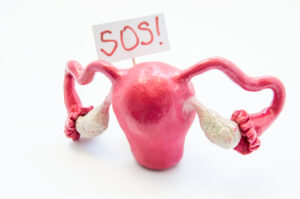 Uterine fibroids are the most common benign tumor of the uterus and their incidence increases over the reproductive years until menopause. Uterine fibroid tissue is made up of smooth muscle cells in the myometrium and are hormonally dependent on estrogen and progesterone and because of this, are the most symptomatic in the years prior to menopause. Many fibroids cause no symptoms, but others can cause abnormal uterine bleeding, symptoms of pelvic pressure, urinary frequency and constipation. Other risk factors besides being a menstruating women include family history, hypertension, obesity and race, with an increased incidence in U.S. Black women compared with White, Latina and Asian women.
Uterine fibroids are the most common benign tumor of the uterus and their incidence increases over the reproductive years until menopause. Uterine fibroid tissue is made up of smooth muscle cells in the myometrium and are hormonally dependent on estrogen and progesterone and because of this, are the most symptomatic in the years prior to menopause. Many fibroids cause no symptoms, but others can cause abnormal uterine bleeding, symptoms of pelvic pressure, urinary frequency and constipation. Other risk factors besides being a menstruating women include family history, hypertension, obesity and race, with an increased incidence in U.S. Black women compared with White, Latina and Asian women.
It has been routinely thought that since menopause has a natural decrease in the ovarian production of hormones, logic has it that most fibroids should regress and symptoms improve or resolve. However, a recent study in 2021 confirmed findings from other studies as well, that fibroids can actually increase in size in the postmenopausal women. Yes, there is a decrease in the body’s production of hormones postmenopausally, but they are still present. This study also confirmed findings consistent with previous studies, that obesity is associated with a higher growth rate of fibroids, no matter in premenopause or postmenopause. And severe obesity is much higher in incidence postmenopause. Obesity doubles the risk of uterine fibroids in postmenopausal women.
Uterine fibroids cells express aromatase, which also exists in the subcutaneous fat layer and is a local synthesizer of estrogen.
In this current study of 102 postmenopausal Asian women living in Beijing, China, with a total of 132 fibroids, the study found that there was a greater growth rate in smaller fibroids < 3cm compared to those that are 5cm or larger. This study also confirmed that obese women had a growth rate of 26.6% and overweight women 15.9% higher than normal weight women.
Commentary: This study emphasizes the impact of weight on growth rates of fibroids and also points out the myth that all uterine fibroids get smaller after menopause, at least in Asian women in China. It is important to point out that other research points to similar results in that fibroid growth rates in postmenopausal women did not decline with age. Other research reports that fibroid growth rates in women under 35 years of age were twice as fast as those in women over 35 years. (69% vs. 30%) In addition, White women over 45 years of age had slower fibroid growth than those who are younger but the fibroid growth rate in Black women did not decline with age. While the 30s and 40s are associated with the most likely growth rate times, it is important to not discount the impact of fibroids and possibly growing fibroids, albeit slowly, in postmenopause.
Reference: Shen M, Duan H, Chang Y, Wang S. Growth of surgically confirmed leiomyomas in postmenopausal women: analysis of the influencing factors. Menopause: J NAMS 2020; 28(11):1209-1213

